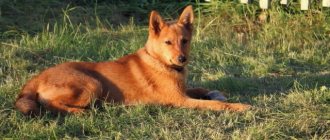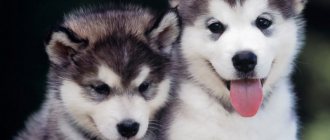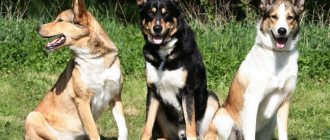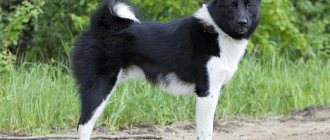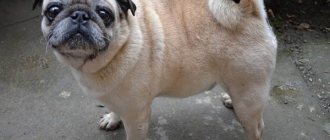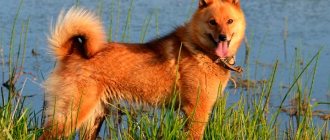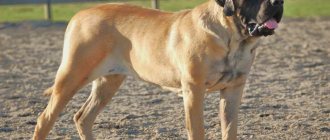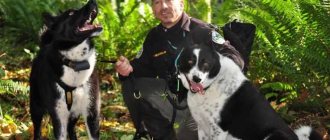| Intelligence: |
| Aggressiveness: |
| For security: |
| For children: |
| Training: |
| Difficulty in care: |
The breed was formed in very harsh and difficult climatic conditions for life in Eastern Siberia. The dogs had to do the hard work of dragging loads, and the breed was created for these purposes. In the 20th century, the Eskimo Laika breed became widespread in Alaska and Greenland. These dogs are very hardy, are not afraid of strong snowdrifts, frosts, and have a strong-willed character. Good guards and hunters, they were often used to catch polar bears.
This variety of huskies is quite closely related to the following breeds:
- Siberian Husky.
- Malamute.
- Laika Samoyed.
Appearance description
The Eskimo Laika is a northern sled dog. The breed is unique, quite large and has a great resemblance to wolves. Dogs are very hardy to severe frosts and are often used as labor. This breed practically does not bark and howls like a wolf.
- The shape of the head is quite wide and wedge-shaped with a smooth transition.
- The ears are triangular in shape and small in size.
- The muzzle is of medium length and tapers towards the nose.
- The jaw is very strong and powerful.
- The eyes are slanted and set quite deep.
- The muscles are very well developed, they have wide shoulder blades.
- The tail is very fluffy and is carried over the side of the back.
- The wool reaches 15 centimeters.
- The legs are strong and muscular.
- The color can be any, there are no restrictions.
- Height – (51-69 cm)
- Weight – (27-47 cm)
- Life expectancy – (13-15 years).
From the history of the breed
The Eskimo Laika breed appeared and developed in the difficult climatic conditions of Eastern Siberia. In order to survive, a huge resource of vitality was required there. Moreover, the main function for which Eskimo huskies were created was hard work. This determined the strong-willed and strong character of the dogs, as well as their appearance. In the 20th century Eskimo huskies came to Greenland and Alaska, where they quickly became widespread due to their exceptional working qualities. In Greenland, northern Canada and among the Inuit, dogs of this breed were also called kingmik. The Eskimos actively used these animals as transport dogs, because they have the ability to transport the heaviest loads over long distances, and at the same time they are very hardy and are not at all afraid of huge snowdrifts and severe frosts. Moreover, Eskimo huskies can not only carry heavy loads, but also pull fishing boats ashore. And due to the fact that these dogs have a keenly developed sense of territory, which they instinctively divide into their own and that of others, they also cope well with guard functions. They often hunt polar bears with these dogs.
Character
Do not forget that the Eskimo husky is a pack animal , you should not expect excessive affection from it, this is not typical for it, it just so happens that the breed is wild and independent . But they treat people very well and rejoice in the praise of their owner.
This breed does not expect constant praise from a person, its representatives behave a little arrogantly, but still they become attached to their owner, but not as strongly as representatives of other breeds.
The Eskimo husky is a very good watchman, the owner should not worry about this; if you let it out of the enclosure, you can be sure that the “stranger” will definitely not get past you.
Character and behavior
Inuit dogs are characterized by loyalty, courage, extraordinary intelligence and endurance. Many have a more or less pronounced hunting instinct. Adaptive and instinctive intelligence is well developed.
The Canadian Eskimo Husky is very hardy, brave and independent. She quickly adapts to changing conditions, strictly follows the hierarchy and is able to provide herself with food in case of urgent need.
Breeders say that the character of these dogs is very tough. They are hardworking, independent and fearless towards wild animals. They can be quite confrontational and aggressive. They love attention and company. Being family members, they grow up loyal, but are rather stingy in expressing feelings and behave rather aloof. Those who are not properly trained may react to children as a potential threat.
The Canadian Eskimo Husky tends to be dominant. Therefore, the owner must have sufficient experience and knowledge to properly raise and train the dog. They show curiosity or indifference towards strangers, provided they are well socialized, and are in no hurry to make contact.
Health
This type of husky has fairly good health . The only disease to which they are prone is a disease of the musculoskeletal system.
It is worth noting that at home, even if you constantly walk a lot with your pet, she will still not receive the physical activity she needs, and this will undoubtedly affect her health. To protect your pet from unnecessary diseases, you should give him a small amount of cottage cheese every day and do not forget to add raw vegetables to his food.
Health and life expectancy
In former times, Inuit dogs were famous for their good health and endurance, but, as it turned out, they are susceptible to infectious diseases; the immune system did not cope well with pathogens uncharacteristic of the Arctic climate. Later, the need to increase the population with a limited gene pool became the reason for the emergence of various hereditary pathologies. There have been no studies on this topic, but cases of diseases are known:
- Hip dysplasia;
- Elbow dysplasia;
- Gastric torsion;
- Corneal dystrophy;
- Progressive retinal atrophy.
Life expectancy is 12-14 years.
Care
This breed does not require special care; sometimes it needs to be brushed. In this breed, the word “care” more implies in its meaning providing the dog with proper nutrition and constant physical activity. In no case should the animal be given baked, sweet, spicy, salty foods; it is also not advisable to constantly feed them dry food; especially in this breed, they have a very bad effect on the dog’s kidneys and liver.
Canadian Husky
Origin
The Canadian husky worked with Eskimo hunters to find seal holes and trap large predators such as polar bears. It was also used for sledding. There are said to be 20,000 of these huskies in Canada in the 1920s. However, within just 50 years, with the invention of the snowmobile, their numbers dropped to 200 as people no longer needed sled dogs. Dedicated breeders decided to save the breed, but the Canadian Husky is quite rare outside of Canada.
Character
The Canadian Husky is more of a specialized working breed than a family pet. This breed was bred specifically for heavy work: the dogs can carry up to 80 kg of cargo, walking more than 70 miles a day in the harsh conditions of the Arctic. Such dogs will not be able to feel happy in normal home conditions: their purpose is to transport goods. However, the Canadian Husky loves people. She is playful, curious and sociable.
Behavior
Pomeranians come in all sizes and can suit almost any household, as long as you don't mind the shedding hair and noise! Larger Spitz dogs are quite energetic and need a lot of physical activity. For small representatives of the breed, a smaller volume of loads is sufficient, but a lot of games and active interaction with their owners are required. They have thick fur, so they do not tolerate hot weather (or too much central heating). Their coat requires regular care.
Health (problems)
The Canadian Husky is generally a robust dog with few common health problems.
Physical exercise
The Canadian Husky needs significant exercise - at least two hours of daily exercise. Energetic entertainment, such as sled racing, is a must for a dog. However, vigorous exercise should be avoided in warm weather due to the possibility of heat stroke for your pet.
Nutrition
Large dog breeds with large appetites require a different combination of nutrients, including minerals and vitamins, than smaller dogs.
Grooming
The warm coat, which performs a protective function, consists of a dense undercoat and an outer layer with hairs 8-15 cm long. Males have thicker and longer hairs (“mane”) around the neck and shoulders. The coat should be combed approximately twice a week. However, during active shedding periods, daily brushing will be required.
The best breeds for children
Dogs are generally considered to be good with children. However, dogs and children must learn to get along with each other, respect each other and feel safe being together. In any case, small children should not be left alone with a dog; adults must supervise all interactions between them.
Nutrition
It should be noted that this breed is completely unpretentious . Eskimo huskies eat less than other breeds and should never overeat. Overeating can lead to obesity and other diseases. It is very important for this dog to always be in sports shape. Your diet should include boiled meat every day, mostly beef. Boil the meat for them for at least an hour. It is also recommended that this breed's diet include boiled fish. The portion is determined based on the activity the dog will have during the day. An active dog with constant training and all kinds of physical exercise should receive a larger portion than a less active one.
It is also imperative that the dog is constantly given boiled bones to chew on, from which it will receive minerals. A vitamin-mineral complex must be included in the diet .
An adult dog is fed twice a day, puppies 4-5 times a day . Eskimo huskies must have nuts in their diet to prevent diseases of the musculoskeletal system, as well as to further strengthen their teeth.
It is imperative to add finely chopped raw vegetables to your dog’s main food. They contain more useful elements than boiled or fried vegetables. You can add a little salt to the food.
Let's look at a sample menu for an adult dog:
- 300-400 grams of boiled meat.
- 150 grams of boiled rice.
- 120 grams of raw vegetables.
- 20 grams of bread.
- During heavy physical activity, be sure to give a raw egg.
It should be remembered that you cannot feed an adult dog during the day , only strictly in the morning and evening. It is also very important to mention that summer is a difficult time of year for a northern dog; its body is ideally adapted to severe frosts, but not to very hot summers. Therefore, you should take care of the shade in the dog’s enclosure so that there is always plenty of clean and cool drinking water for it.
Maintenance and care
Since Eskimo huskies come from the harsh conditions of the cold and snowy north, accustomed to severe frosts, they cannot easily tolerate the heat.
Therefore, in the summer, the owners are obliged to organize for her shaded places to rest with cool drinking water.
Due to its love for freedom and large open spaces, it is strictly forbidden to have a husky in an apartment.
They rarely bark, but rather howl like wolves, which will undoubtedly cause an uncomfortable stay for neighbors.
Also, due to a sedentary lifestyle in an apartment, they may suffer from obesity and other diseases.
A good living condition would be a spacious enclosure in which she can always be on the move.
Walking and physical activity should be regular, several hours a day.
You should keep your dog's coat clean and brush it occasionally, especially during the shedding period.
Photo of Eskimo Laika
Canadian Eskimo Dog – about $3,000
Due to its rarity, the Canadian Eskimo dog is considered one of the most expensive dog breeds in the world. The price of a puppy can reach up to 7 thousand dollars and more.
Representatives of this beautiful, strong and freedom-loving breed do not bark, but “sing” in a drawn-out manner. The Canadian Eskimo's thick coat allows them to withstand severe frosts, but they shed frequently and are not suitable for owners with allergies. In addition, these dogs are very stubborn and raising them will require endurance and firmness from a person.
Character and intelligence of the Eskimo husky
Representatives of this breed cannot be called flexible and good-natured. These dogs are smart, learn quickly and are good watchdogs. But they perceive a person not as a master, but as a leader and companion and demand respectful treatment. And if a dog wants to be left alone for a while, then its wishes should be respected, because in the north people live with these dogs in a kind of symbiosis and are highly dependent on their dogs, so the attitude there is strictly respectful, and not consumerist or patronizing.
Gullibility is not one of the advantages of this dog. The owner and his family will have to work hard to get the Eskimo husky to accept them. But if she has already done this, then it is difficult to find a more faithful and devoted companion. Representatives of this breed perceive their family as members of a pack and treat them accordingly, so the owners of these dogs claim that they can safely leave their children with the Eskimo Laika. But children must also understand that a dog is not a toy, otherwise the dog itself will explain this to them, and he will perceive this as raising unreasonable puppies.
Training and education of the Eskimo husky
When training a dog of this breed, you must remember that it resembles a wolf not only in appearance. She even has similar habits, for example, she does not like to bark, but prefers to howl. The way wolves do it. And she will obey the owner only when he shows that he is the leader of the pack. But this also has its advantages: the like will obey such an owner unquestioningly. It is only important to choose the right tone and the right attitude.
When working with this animal, even an experienced owner may need the help of a trainer. But the owner must remain the main one in the pair, otherwise he will not be perceived as the leader. And you should not try to make this dog a home companion. She can become a loyal friend who protects family members, but she needs closeness to nature. Ordinary walks in the park are not enough here. You need to take her for long walks in the forest, in nature. Ideally, she needs to hunt and run a lot. That is why she cannot live in the city.
